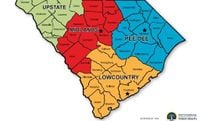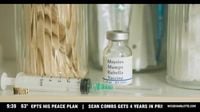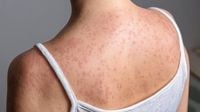The United States is grappling with a surge in measles cases, as outbreaks in Utah and South Carolina highlight the growing threat posed by declining vaccination rates and persistent gaps in community immunity. Health officials in both states have sounded the alarm, urging residents to check their immunization status and take immediate precautions as the highly contagious virus continues to spread.
In Utah, the Department of Health and Human Services reported 47 confirmed measles cases as of October 4, 2025, marking an increase of three cases within just the past week, according to Gephardt Daily. The Southwest Utah Health District, encompassing areas like Cedar City, has borne the brunt of the outbreak, now accounting for 33 of the state’s cases. The most recent exposure was traced to Innova Tech in Cedar City on September 26, with health officials advising anyone potentially exposed to monitor for symptoms until at least October 17.
The numbers tell a sobering story: of the 47 confirmed cases in Utah, 45 occurred in unvaccinated individuals, one in a vaccinated person, and one in a person whose vaccination status remains unknown. This pattern is not unique to Utah. In South Carolina, the Department of Health and Environmental Control (DHEC) has confirmed eight measles cases as of October 5, 2025, with five of those cases emerging in just the past month. Most of the infected individuals in South Carolina were either unvaccinated or only partially vaccinated, according to The Economic Times.
The outbreak in South Carolina is centered around the Upstate region, particularly Greenville and neighboring counties. Health authorities have activated contact tracing teams, issued statewide exposure alerts, and stepped up vaccination drives in an effort to contain the spread. The situation is considered one of the state’s most serious health scares in recent years, reigniting concerns over falling immunization rates and the risks posed by vaccine hesitancy.
Dr. Linda Bell, the state epidemiologist and Health Programs Branch director, emphasized the gravity of the situation. “The unknown source of two of the cases indicates unrecognized community spread,” she warned, according to the South Carolina Department of Public Health. “We anticipate more cases will be identified and implore community members to act responsibly. If you are ill, stay home. Notify a health care provider by phone of symptoms suggestive of measles before visiting a clinic. Follow guidance for control measures and cooperate with DPH investigations. At this time, it is very important to get better protection against measles spread in our communities by increasing measles vaccination coverage.”
The measles virus, a member of the paramyxovirus family, is notorious for its ability to spread rapidly. It can linger in the air for up to two hours after an infected person leaves a room, and a single infected individual can transmit the disease to as many as 18 unvaccinated people in close contact. Symptoms typically appear seven to fourteen days after exposure and include high fever, cough, runny nose, red eyes, and a red rash that starts on the face and spreads across the body. The rash usually lasts five to six days, and those infected are considered contagious from four days before the rash appears until four days after its onset.
Measles is not just an inconvenience—it can lead to severe complications such as pneumonia, ear infections, and inflammation of the brain (encephalitis), particularly in infants, pregnant women, and people with weakened immune systems. While no hospitalizations or deaths have been reported in the current South Carolina outbreak, health experts caution that the coming weeks are critical. As contact tracing continues, new cases could emerge, especially if unvaccinated individuals have unknowingly carried the virus to new communities.
In response to the outbreaks, local hospitals and clinics in both states have increased testing capacity and implemented stricter safety procedures. Suspected measles patients are being isolated, and medical staff are using additional protective equipment to reduce the risk of exposure. In South Carolina, schools across several Upstate districts are reviewing student vaccination records and reminding families that unvaccinated students may be required to stay home if potential exposure occurs, in accordance with state health regulations. Administrators have been instructed to report any cases of noncompliance, and some districts have issued clear warnings about the consequences of failing to follow immunization requirements.
Community outreach efforts are also ramping up. Health workers in South Carolina are visiting affected neighborhoods to provide free vaccines and share accurate information about measles prevention. Vaccination clinics have been set up in several Upstate communities, and those who may have been exposed but are not fully vaccinated are being offered the MMR (measles, mumps, rubella) shot immediately. The MMR vaccine remains the most effective protection against measles, with two doses providing about 97% efficacy. Children should receive the first dose at 12 to 15 months of age and the second between ages four and six. Adults unsure about their vaccination history are being urged to consult with their healthcare providers.
As Dr. Bell noted, “Measles-mumps-rubella (MMR) vaccination remains the most important tool for preventing measles infection and spread. We strongly encourage everyone to review their immunization records and make sure they are up to date on all recommended vaccinations, including MMR.”
The Centers for Disease Control and Prevention (CDC) reports that, as of September 30, 2025, there have been 1,544 confirmed measles cases across 41 states, with more than 40 outbreaks reported this year. A staggering 86% of these cases are outbreak-associated, underscoring the national scope of the problem and the urgent need for vigilance.
For those wondering what to do, officials across both Utah and South Carolina have clear advice: verify your vaccination records, stay home if you develop symptoms, and avoid public gatherings until you’ve been cleared by health professionals. Parents are being urged to keep unvaccinated children at home if they develop cold-like symptoms or a fever. Simple precautions—like washing hands, covering coughs, and maintaining distance from the sick—can make a real difference in halting the spread.
Doctors and public health experts are adamant: outbreaks like these serve as a wake-up call. Diseases once thought to be nearly eliminated can return if communities let their guard down. The message is simple and urgent—prevention through vaccination remains the strongest shield against avoidable illnesses like measles.
As the next two weeks unfold, all eyes will be on Utah and South Carolina’s public health response. The outcome could set the tone for how the nation tackles the resurgence of vaccine-preventable diseases in a time of growing skepticism and misinformation. For now, the best hope lies in swift action, robust community cooperation, and a renewed commitment to the power of immunization.


